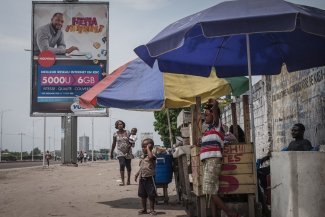In March 2018, the Iranian photographer Mehri Jamshidi travelled roughly 650 kilometres from the Iranian capital of Tehran to the Iran-Turkmenistan border. There, she visited a small county that is rich in culture and nature, but where locals experience some of the highest poverty rates in the country. A community of Iranian Turkmen, who only make two per cent of Iran’s 80 million-plus population, live the city of Maraveh Tappeh and in 130 surrounding villages in Golestan Province – 110 of which are supported by governmental organisations.
In a country with the largest Shia Muslim population in the world, Turkmen are Sunnis. For centuries they lived as nomadic herdsmen, and while most Turkmen today live sedentary lives, they are renowned as farmers and cattle breeders. Language differences (the people of Maraveh Tappeh speak Turkmen which is completely different from Persian) and cultural differences, coupled with the fact that these communities are situated a great distance from Iran’s urban centers, cause severe social and economic issues for the residents of Maraveh Tappeh.
This region has a high rate of babies born with disabilities such as Down’s syndrome, autism and genetic diseases as a result of consanguineous marriages, poor healthcare facilities, malnutrition and waterborne diseases. In addition, while the Turkmen of Iran are deeply dependent on agriculture, the region where they live in has suffered from drought in recent years, which has drastically changed the landscape and the farming system of this poor region. As a result of water shortages, high unemployment and poverty in Maraveh Tappeh, many local men have migrated to the big cities where they end up working as day labourers or doing other manual jobs.
All this has had a huge impact on the women of this Turkmen community. Although there is little difference between the struggles faced by the women of this community and women from other deprived communities in Iranian, the relative isolation of the Turkmen compounds their situation.
Although enrollment rates are almost equal between girls and boys in the region, many young girls drop out of school due to the long distance between the schools and the villages in which they live. It does not take long for a young girl out of school in Maraveh Tappeh to become a child bride. “Despite cultural and religious differences, the women of Maraveh Tappeh have similar stories to women in other parts of Iran,” says Mehri Jamshidi. “But the unfinished childhood of the young girls of the region is a forgotten story that resonates with women far and wide.”

Aman helps her elderly father to clean his house. “My father sleeps during the day; He rarely notices my presence while I am doing his chores,” she says.
With so many men moving to the towns and cities for work, young women in Maraveh Tappeh often find themselves as the primary caretakers for their older relatives. As well as affecting the educational prospects of many young girls, this can also affect their ability to marry. As almost everyone here lives off the land, women also have to tend to the cattle as well doing their household chores. And while some elderly residents receive monthly benefits from the government, the money is not enough to pay for all of their needs.

Hasal herds her family’s cattle in the village of Soozesh in Maraveh Tapeh.
Soozesh is one of the villages that will vanish forever once a new dam over the Atrak River is completed. According to government plans, the residents of six villages will be moved to a new area. Three of these villages – Soozesh, Khoje Galdi and Sari Ghamish – will be relocated to Ging Jay about eight kilometres away which is close to their farm lands. But the residents say their future is uncertain: “We have been living in limbo for about eight years. We can’t make any decisions about our lives,” Hasal told Equal Times.

Gol Oghool Garak, 53, rests after a seizure.
Gol Oghool suffers from seizures and her 28-year daughter is profoundly autistic. There are numerous cases of autism and disabilities amongst the children of this region as a result of cousin marriages and limited access to post-natal healthcare services.

Nine-year-old Fahimeh Gorganli is in the third grade of primary school. She is resting on the floor of her grandmother’s house after attending a wedding party.
An individual donor constructed a primary and secondary school in the village of Yaz Galdi but many girls in the region drop out of school due to the limited places and the far distances children have to travel to go to school. Fahimeh’s parents are concerned about child marriage, as many local girls start to get married from the age of about 13. “Fahimeh is growing up so fast,” her mother told Equal Times. “I worry that I will have to accept her early marriage in few years’ time.”

Seventeen-year-old Mahdieh is standing in her aunt’s yard, taking a break from rounding up cows in her family’s herding ground.
Mahdieh dropped out of school at 15. The nearest high school to Yaz Galdi village is about seven kilometres away and Mahdieh says she missed being with her family while studying at the school. She hopes to get married soon.

Young women attend their 17-year-old sister’s wedding party in the village of Korand.
All the girls in this photograph are married and none of them completed their schooling. In the most traditional families, girl children are declared ‘engaged’ to their male cousins as soon as they are born. There is a belief that by marrying girls at a young age, they are protected from harm.

A woman braids her daughter’s hair in preparation for a wedding party in Korand.
Although accurate data is hard to come by, according to the United Nations children’s agency UNICEF, 17 per cent of girls in Iran get married before the age of 18. Cultural traditions, a lack of educational opportunities and poverty are the main drivers of underage marriage in this region.











